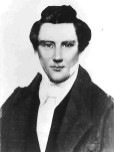
FAIR is a non-profit organization dedicated to providing well-documented answers to criticisms of the doctrine, practice, and history of The Church of Jesus Christ of Latter-day Saints.
| Answers portal |
| Joseph Smith, Jr. |

|
|
|
|
|
Many of Joseph Smith’s friends and neighbors signed affidavits that accused him and his family of being lazy, indolent, undependable treasure-seekers. Why did they do this?
To see citations to the critical sources for these claims, [[../CriticalSources|click here]]
Many critics cite a collection of affidavits from Joseph Smith’s neighbors which claim that the Smith family possessed a number of character flaws. These affidavits were collected by Doctor Philastus Hurlbut ("Doctor" was his first name, not a title).[1] Hurlbut had been excommunicated from the Church on charges of "unvirtuous conduct with a young lady,"[2] and for threatening the life of the Prophet.
Hurlbut's hostility to the Smiths may have been of long date. In 1819, the Smiths sued a local family of Hurlbuts over the sale of a pair of horses and some work they had done for him. (Aside from the name, it is not known if there was a family connection.) One author explains:
At any rate, Hurlbut's later collection of statements was made at the request of an anti-Mormon committee in Kirtland, Ohio.[4] According to B.H. Roberts:
Hurlbut was unable to publish the affidavits himself after his trial for making death threats against Joseph Smith, Jr. (And, it is possible that his family's animus dated back far longer.) He sold his material to Eber D. Howe, who published it in his anti-Mormon book Mormonism Unvailed in 1834. In addition to the affidavits attacking the character of the Smith family, Hurlbut gathered statements from the family and neighbors of Solomon Spalding in order to "prove" that Spalding's unpublished manuscript was the source for the Book of Mormon. Mormonism Unvailed contained the first presentation of the Spalding theory of Book of Mormon origin. Some critics, such as Fawn Brodie, are selective in their acceptance of Hurlbut's affidavits—They readily accept affidavits that attack the character of the Smith family, yet admit that some "judicious prompting" by Hurlbut may have been involved in those affidavits that were gathered to support the Spalding theory.[6]
Howe's bias is evident throughout the book. He introduces the Smith family with the following:
The following table summarizes the claims made in the Hurlbut affidavits regarding Joseph Smith, his family and his associates.
| Claimant | Claims | Comments |
|---|---|---|
Parley Chase |
|
|
Joseph Capron |
|
|
Lemon Copley |
|
|
Alva Hale(Son of Isaac Hale) |
|
|
Isaac Hale(Father-in-law of Joseph Smith, Jr.) |
|
|
Henry Harris |
|
|
Nathaniel Lewis(Brother-in-law to Isaac Hale and a Methodist deacon) |
|
|
Joshua M'Kune |
|
|
Roswell Nichols |
|
|
Barton Stafford |
|
|
David Stafford |
|
|
Joshua Stafford |
|
|
G. W. Stoddard |
|
|
Milton V. Backman wrote:
B.H. Roberts contrasts the achievements of the Smith family with the accusations made against them:
| Claimant | Claims | Comments |
|---|---|---|
Willard Chase |
|
|
Peter Ingersoll |
|
|
C.R. Stafford(nephew of William, below) |
|
|
William Stafford(uncle to C.R., above) |
|
|
Commentary
| Claimant | Claims | Comments |
|---|---|---|
Charles Anthon |
|
|
| Claimant | Claims | Comments |
|---|---|---|
Abigail Harris |
|
|
Lucy Harris(Wife of Martin Harris) |
|
|
Commentary
| Claimant | Claims | Comments |
|---|---|---|
Levi Lewis |
|
|
Sophia Lewis |
|
|
Hezekiah M'Kune |
|
|
Commentary
Hurlbut's affidavits regarding the Spalding manuscript consist of interviews with family and associates of Solomon Spalding.
| Claimant | Claims |
|---|---|
Artemas Cunningham |
|
Nahum Howard |
|
Henry Lake |
|
John Miller |
|
Oliver Smith |
|
John Spalding(Brother of Solomon Spalding) |
|
Martha Spalding(wife of Solomon Spalding) |
|
Aaron Wright |
|
Commentary
See also:
==

FAIR is a non-profit organization dedicated to providing well-documented answers to criticisms of the doctrine, practice, and history of The Church of Jesus Christ of Latter-day Saints.
We are a volunteer organization. We invite you to give back.
Donate Now